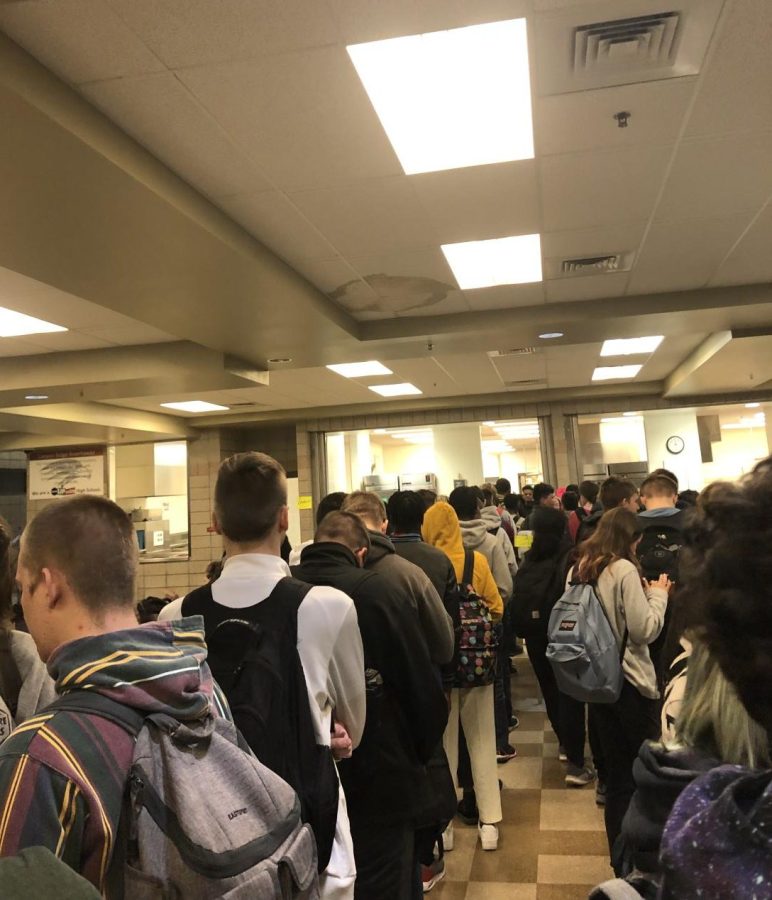Does the 35-minute lunch work for everyone?
November 15, 2022
Imagine you have just spent all morning in stressful classes and you finally make it to lunch time, one of the only parts of the day where you can relax. You head to the lunch line where you wait your turn to receive the school lunch. Minutes pass by and precious lunch time ticks away. Finally, you make it to the head of the line, get your food, and sit down. You look at the clock: there’s only seven minutes left to eat. For some students, this narrative is accurate to their lunchtime experience.
For many students and staff members at Canyon Ridge High School, lunch is an important part of the day. It’s the only time in the school day where students and staff can enjoy a meal, chat with friends, and hopefully get a little bit of relaxation. Because it is such an important part of the day, many people have different opinions on lunch. More specifically: the amount of time given for lunch.
Here at our school, students are typically given 35 minute lunch breaks with the exception of assembly days where they are given hour-long lunches. Many students think that this is not enough time for lunch. This raises the question: What goes into making this lunch schedule?
In an interview with Dr. Kasey Teske, the Principal of Canyon Ridge, he said that the lunch schedule was created by the Building Leadership Committee, a group of teachers and administrators who create a lot of the decisions and rules. He also said that one of the biggest factors that goes into decided how much time is allowed for lunch is the bus schedule: “You can have longer lunches but then you have a longer schedule, and that sounds really good [and], well, we don’t mind going fifteen minutes over, we could get out at 3:45 and have a longer lunch, but the problem is the bus schedule. What they can do limits us or dictates our start and stop time.”
Another factor that was mentioned by Teske was that classes need a certain amount of sit down time per year.
Teske also said that there has not been a lot of changes in the lunch concerning the amount of time given, and states that he does not foresee any changes in the coming years (sorry to everyone who got their hopes up about longer lunches).
For students who eat school lunch, one of the main problems they face is the long lunch lines.
Scott Thompson, Vice Principal of Canyon Ridge, when asked what sort of changes for the lunch he would like to see, replied, “What I would like to see is more lunch windows. Instead of just two lines, I would like to see the option of three open windows, that would be three lines, and an optional salad bar, which could actually turn into four lines, but they won’t give us enough kitchen workers to be able to feed that many open windows.”
The lack of kitchen workers is a major reason why the lunch lines are long. Thompson said, “We just don’t have enough lunch workers to offer more options. Back in the days before COVID or right around that time, we had a pizza line everyday, we had a sandwich line everyday, and then we had ‘main line’, I think is what they would call it, and then at times we would have a soup or salad line and that really helps on lunch line sizes.”
In an interview with Cassandra Rosa, the Kitchen Manager, she said that there used to be 8 kitchen workers, but now they are down to 3. She also said that there are 27 open kitchen staff positions, but no one is applying. “We used to have four [lunch] options everyday, now we have two because we’re short staffed.”
Rosa also said that the number of kids who eat the school lunch has gone down significantly, “When I first got here we were feeding roughly 600 hundred [kids] and now we’re at 270. We don’t even feed 300 out of 1400 plus kids,” states Rosa.
In a survey taken from 68 students, it was revealed that 74% of students almost never eat school lunch. Out of the 26% of students who eat school lunch at least once a week, 28% said they wait in line for 1-10 minutes, 56% said they wait for 10-20 min, and 16% said that they wait for 20 minutes or over.
When asked if she thought the lunch was long enough for students to eat, Rosa replied, “No, Thirty minutes isn’t a long time , really, for anybody to eat… I strive really hard to try to at least give you guys ten minutes to eat, but I know that sometimes it doesn’t come out that way.”
Thompson did state that students who are still in the lunch line when the bell rings are allowed to sit and eat and are given a tardy slip.
Being tardy to the fifth hour is a big issue for many students. Around 20% of all tardies come from the fifth hour. In the survey previously mentioned, when asked how many days a week they felt rushed during lunch, 57% of the students answered that they felt rushed 3-5 days a week. Feeling rushed during lunch makes a lot of students feel dissatisfied with the amount of time given to them.
Another question asked in the survey was the student’s level of satisfaction for the amount of time given for lunch. Of the students polled, 2% said that they liked it, 16% said it was alright, 26% were neutral, 40% said they didn’t really like it, and 16% said that they hated it.
It can be inferred that many of the students are not a huge fan of the time given for lunch. But for students like Tessa Bornholdt, a junior and a foreign exchange student from Germany, this is a good amount of time for lunch. She said that she was given around an hour for lunch at her previous school. In an interview with her, she said, “I think it [the amount of time given to her in her last school] is a very long time because then you just sit there and do something with your friends but it’s not really productive… The half hour you have here is way better because you can eat and then afterwards you can get your periods done and then you can go to your home earlier than if you have too much lunch.”
One idea that was brought up by both Rosa and Thompson is the two lunch idea where half of the students go to one lunch and the other half goes to the other. This was a lunch schedule that was used during COVID but was done away with when the pandemic died down.
When asked about her opinion on the two lunch schedule, Rosa replied, “Personally I think that two lunches would be good. I think that we would possibly feed more and then two, it kind of stinks, because I’m here by 5:45 every morning, so you put all this prep work into thirty minutes of serving and then you’re done… So I think that the two lunches would benefit because our count would increase, our numbers would increase.”
Thompson was also in favor of the two lunch schedule, “I didn’t mind the two lunches just because there were less problems because there were less students out of class, and you know half of the school is at lunch, behaviors and discipline and things like that were a little easier.”
However, there are definitely some flaws in the two lunch schedules. As Teske pointed out, “we could have a split lunch like we had during COVID where half the students went at one time, and half the students went at another time, which isn’t ideal because then people sometimes get separated from their friends. Seems like we had more complaints about that then we did about the long lines.”
Making the lunch schedule is a complicated issue and there are many factors that go into creating a “good” lunch experience. It is impossible to change things to fit everyone’s wants and needs and someone will always be unhappy, but the hope of the kitchen staff and administrators is that everyone will have a chance to eat.



Mason Hill • May 24, 2023 at 8:50 am
I agree that there isn’t enough time for everyone to get their food, eat it and enjoy relaxing with their friends. However, the system we have seems to be substantially efficient, and changing it could have negative outcomes. For how the lunch staff is short-handed they would have to serve longer to people and not get much of a break. With the increase in lunch time, students would be more likely to be late to their fifth-hour class because they would get lackadaisical and would prefer to get a longer break before their next class.
Adelynn Coy • Jan 25, 2023 at 8:54 am
I think that there will always be challenges with lunches no matter what we do but I do find the valid points in this article very helpful. Great job!